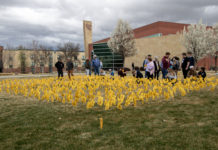More than 60 miles down Highway 50 lies Colorado Mesa University’s Montrose campus. Attached to the Montrose Public Library, the campus is significantly smaller than CMU’s main campus in Grand Junction. The whole university is about the size of one wing of Houston Hall, according to John Marshall, vice president of student services.
According to the CMU website, the Montrose campus offers seven programs, some of which have several degree options: medical office assistant, business, education, nursing, sports management, humanities and social sciences.
Its enrollment is less than one percent of CMU total number of students. For the fall 2017 academic year, 277 students enrolled as either part- or full-time learners at the Montrose campus, according to numbers provided by Media Representative Dana Nunn. Only 164 of these students study exclusively at Montrose since many of the programs eventually require higher level courses on the main campus.
But, despite its small size, the campus fulfills an important role in CMU’s greater mission for educating the four main counties of western Colorado.
“The anchor or our mission, why we exist, stems around Mesa, Delta, Montrose, Garfield and how we educate those countries,” Marshall said. “Yes, it’s a small group, and yes, it’s important.”
The majority of Montrose students are adult and/or part-time learners, according to Marshall, which is why the majority of the campus’s classes are offered at night. The campus has historically had a small offering of classes, though the opportunities are slowly increasing.
However, at nearly an hour drive from the main campus, a problem without an easy solution arises: Do these students, who pay the same tuition and fees as main campus students, receive the same opportunities?
The answer is not a simple yes or no.
If you ask Nayeli Zavala, the Montrose campus senator for the Associated Student Government, there’s more than could and should be done for these students. Zavala, now a main campus student, attended the Montrose campus for her first two years of school, a fairly common arrangement at that campus.
“Students in Montrose, they pay the same fees as we do on this campus, yet they don’t have the same benefits as we do,” Zavala said. “They don’t have a gym, they don’t have KMSA, clubs, anything.”
The question of gym access has been the cornerstone of this conversation in ASG.
Like all CMU students, Montrose campus students pay $7.22 per credit hour for the recreation center, according to data from the 2016-2017 academic year. Therefore, a student enrolled from August through May at the average of 15 credit hours a semester will pay $866.40 by the time they graduate.
This number doesn’t include other student-fee funded opportunities to which Montrose campus student don’t have easy access, such as the University Center, Programming Activities Council events or Cultural Diversity Board meetings, for example.
Zavala presented a bill to ASG to allocate $2,300 for the purchase of gym passes for Montrose students. Since no student is likely to drive an hour merely to use the Hamilton Recreation Center, which their student fees fund, the providing gym passes for these students seemed like an easy solution.
However, this particular solution has a long history. For the past two years, ASG has passed this bill, first providing gym passes to Gold’s Gym and, last year, for Anytime Fitness. As a new Montrose Recreation Center recently opened, the bill this year would provide students with passes there, as it is the most similar to Hamilton, according to Zavala.
The bill was first proposed in September. Like all ASG bills, it was first screened by the Fee Allocation Committee, who tabled it indefinitely, waiting for more information or a more permanent solution.
Zavala proposed the bill again in January, where it was moved on to ASG. The process was still far from over, as ASG had a lengthy debate about whether or not providing gym passes was the best solution for Montrose students.
Several senators wanted to work on long-term solutions to the process, such as Senator Jeff Vela, who called the solution a “Band-aid fix” during the meeting.
President Ben Linzey echoed these concerns, and at the next general assembly meeting offered two more permanent fixes for the next year: an automatic allocation for the gym passes at the start of every year, or a carving out an amount of money each year as a “Montrose budget” that students on that campus can use as they see fit—whether that be for gym passes or other activities.
Zavala worried that her constituents would be the only ones hurt by delaying the bill as ASG continues to search for a more permanent option.
Though Zavala said later she feared the bill wouldn’t pass—one of her concerns with the current system of proposing the bill each year—it was approved by a narrow margin of 11-10.
“We always have to introduce this bill, and it’s getting kind of annoying,” Zavala said.
The gym issue is only a small example of a larger question of fairness and equity regarding how student fees are shared between the two campuses. The distance of the campus, combined with the fact that most classes are at night, prevent most Montrose students from joining a club, writing for The Criterion or even coming to support their senator as she presented her bill to ASG.
Though at first glance the situation seems wholly unfair, there’s another side of the issue to be considered: the financial and logistical standpoint of running an incredibly small campus.
“From just a raw numbers standpoint, it’s a relatively small group. From a mission standpoint, it’s important,” Marshall said.
According to Marshall, questioning whether or not the sharing of student fees is fair between the two campuses when the majority of extracurricular ones are located solely on the main campus is only half of the question.
The other side of the issue is weighing the financial inefficiency of the Montrose campus with its benefits for Delta and Montrose counties, which are historically two of the lowest academic attainment counties on the western slope.
Marshall explained that the most effective use of tuition dollars is the basic general education course: 50 or more students in a lecture classroom in Houston Hall. On the Montrose campus, however, classes are significantly smaller. In addition, equipment purchased for programs such as nursing is used by fewer students than the equipment on the main campus.
“Literally everything about Montrose is low enrollment, high cost, and sort of inefficient delivery,” Marshall said. “So, you really have to view it not as a cost-benefit dollar investment, because if we did that we wouldn’t be there, but we have to view it from a mission standpoint.”
The idea of “mission” came up frequently in conversation with Marshall, who emphasized that the role of the Montrose campus is simply different than the role of the main campus, especially for its significance in the Montrose community, with whom Marshall said CMU continues to develop a relationship.
“I think viewing this through a more holistic look is critical. Because if we just look at how many student fees they pay, how many are coming back, you miss that we have a mission,” Marshall said.
Certainly, administrators like Marshall and Director of Student Life Shane O’Neill would like to see Montrose students benefit from their student fees as much as possible. The question of how is the most difficult one to answer.
O’Neill and Montrose Advisor Gary Ratcliff have discussed ways to further engage Montrose students with those on the main campus but, once again, the question of distance and feasibility arose.
“Obviously I’d like the students to be a part of everything that they’re able to be,” O’Neill said, but he acknowledged events were particularly difficult to extend to Montrose students due to driving distance. At the same time, if events were held at the Montrose campus, main campus students would be unlikely to drive there.
O’Neill explained that Montrose students receive some of the smaller Student Life projects, such as welcome back backpacks and the stress relief packs that students can pick up before finals week.
Though Marshall warns not the view the situation between the two campuses strictly in terms of equality, since both have different roles and different student populations, Zavala and others in ASG still want to provide more opportunities for Montrose students.
In addition to working on the gym pass issue, Zavala wants to work on creating a study room that’s open late for Montrose Students. While she believes awareness about the main campus and ASG have risen on the Montrose campus since she first attended nearly three years ago, she hopes ASG will visit the campus again and main campus students will, in turn, raise their awareness about the problems at the Montrose campus.






I don’t understand how 30 (thirty) passes that are only good for 3 (three) months for Montrose Campus students is a fair and equitable solution, since there a little over 200 students at the campus. Is this what it’s going to be like for the students here? Nickel and dime solutions.
I appreciate that this article was even written and these problems were brought to light, but I’m hoping this will just be the beginning.